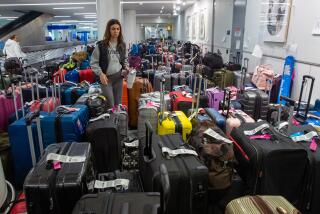Air Travel’s Free Market Works
- Share via
The second immersion of US Airways into bankruptcy, following similar financial disasters of other major carriers, raises understandable questions about what is happening and what is in store for future air service. These concerns are especially poignant in small communities, such as mine in Ithaca, N.Y., for which US Airways is the only service provider.
During the airline deregulation period -- 1977-78 -- US Airways (then called USAir) was the first carrier to invite me to address its executives about the prospects for deregulation and its probable effects. The company had only recently begun expanding from a subsidized regional carrier to one with national ambitions, starting with a name change from Allegheny to USAir. I recall saying something like: “Start thinking about what you’d like to do, what markets you hope to enter, what routes you’d like to withdraw from because you will soon have the opportunity to do both.”
Not long afterward, its chief executive, Edwin Colodny, visited me and said: “Fred, we think you should be the first to know that we’ve decided to drop our nonstop service between Ithaca and Washington.”
I may or may not have blanched, but I thanked him for the advance notice and expressed confidence that airline deregulation would free some other carriers to provide service to Ithaca, to the extent it was economic to do so. Sure enough, within a few weeks, a commuter airline came into the market. It was soon replaced by Empire -- later acquired by Piedmont, which was in turn acquired by US Airways.
So in the end, USAir never really left Ithaca. Moreover, the hub-and-spoke system it developed, centering on Pittsburgh, gave us better service -- the ability, for example, to leave Ithaca in the morning and arrive at almost any major U.S. city before noon, easy access to nations all over the world and a choice of departure and arrival times on important, closer destinations.
In that sense, deregulation was a great success. But for hub carriers, such as US Airways, that success depended on their continuing ability to recover the heavy fixed costs of maintaining that kind of convenient scheduling. They have had to do so with a combination of discounted fares, which help fill their planes, and full fares to travelers who had to be charged increasingly more for the convenience of late reservations, a choice of flights, upgrades and the accumulation of frequent-flier credits.
The low-cost, low-fare airlines, such as Southwest and now JetBlue, Spirit and others, that have offered service on the denser routes for a fraction of the major hub carriers’ full fares attracted millions of travelers, all willing to suffer such inconveniences as long lines, the absence of advance seat reservations and often the use of more distant airports. And then, as the gap between discount and full-fare rates grew, the low-cost carriers gained business travelers as well.
As a result, a major contributor to the financial distress of the big carriers -- magnified by the drop in air travel because of the recession and 9/11 -- has been loss of market share. The low-fare, point-to-point carriers now reportedly carry more than a quarter of all passengers, as contrasted with less than 10% a decade ago. But that too is part of the healthy competitive process.
We Ithacans are lucky to be able to fly to New York on JetBlue at an unbelievable round-trip fare of about $100 -- but only at the inconvenience of the 60-mile trip to and from Syracuse -- while US Airways’ full fares are about $550. But with the recent decline of hub-and-spoke operations, we are suffering from US Airways’ curtailment of its convenient service out of our local airport.
I have no way of predicting how much service US Airways -- or its successor -- will find profitable to continue to supply. How much at Ithaca, how much at Elmira or Binghamton, about 30 and 40 miles away, respectively, no one can know. That’s why we deregulated.
All I can predict with assurance is that the airline industry will continue to offer the public the kinds and amounts of service that we are willing to pay for; and the public can rely on competition to hold rates to reasonable levels. The one thing we should not look for is a return to competition-suppressing regulation.
More to Read
Sign up for The Wild
We’ll help you find the best places to hike, bike and run, as well as the perfect silent spots for meditation and yoga.
You may occasionally receive promotional content from the Los Angeles Times.






